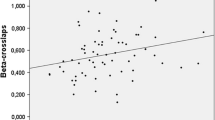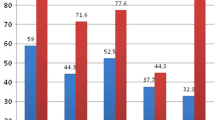Abstract
Osteoporosis becomes a serious health threat for older postmenopausal women by predisposing them to an increased risk of fracture. Osteoporosis and associated fractures are an important cause of morbidity and mortality. Special attention is being paid to early detection, management, and treatment of postmenopausal osteoporosis in women. Biochemical markers can enable dynamic and rapid measurement of total body skeletal metabolism and will be clinically useful in the management of postmenopausal osteoporosis women (PMO) and also for assessing the effects of antiresorptive therapy. With this view, we planned to assess osteoclastic activity by determining urinary hydroxyproline in osteoporotic women. The aim of this study is to measure urinary hydroxyproline (expressed as mg of hydroxyproline/g of creatinine) and serum ascorbic acid in postmenopausal women with osteoporosis and without osteoporosis. These biochemical parameters were determined 3 months post antiresorptive therapy (alendronate + calcium + vitamin D) in postmenopausal osteoporosis patients. 60 postmenopausal women with osteoporosis in the age group 45–60 years and 60 healthy postmenopausal women (normal bone mineral density) in the same age group were included in the study. Urinary hydroxyproline levels were significantly increased (P < 0.001) in PMO at baseline level as compared to control group. These levels were decreased significantly (P < 0.001) post therapy in PMO patients. Serum vitamin C levels were significantly decreased (P < 0.001) in PMO patients at baseline level as compared to controls. No significant change occurred of serum vitamin C level post therapy. Raised excretion of hydroxyproline at the baseline level might be due to increased degradation of collagen type I from the bone matrix in osteoporosis. Breakdown of collagen seems to be lowered as reflected by lowering of hydroxyproline excretion post antiresorptive therapy. Alteration in the concentration of this marker can be very well utilized to monitor the effectiveness of therapy. Thus simple, direct urinary assay to measure bone resorption is very useful in monitoring the therapy in PMO and may become an integral part of the management of osteoporosis.
Similar content being viewed by others
References
Brown SA, Rosen CJ. Osteoporosis. Med Clin N Am. 2003;87:1039–63.
Gupta A. Osteoporosis in India-the nutritional hypothesis. Natl Med J Indian. 1996;9(6):268–74.
Fact and statistics about osteoporosis and its impact. International Osteoporosis Foundation, Osteoporosis Society of India. Action plan osteoporosis. Consensus statement of an expert group, New Delhi. 2011. http://www.osteofound.org/press_centre/fact_sheet.html.
Neetakumar, Ammini AC, Tandon N, Goswami R, Dineshkumar, Singh A. Ethnic variation of host and risk factors in silent epidemic of osteoporosis. Orthop Today. 2004;6(4):240–4.
Sachdeva A, Seth S, Khosla AH, Sachdeva S. Study of some common biochemical bone turnover markers in postmenopausal women. Indian J Clin Biochem. 2005;20(1):131–4.
Axelrod DW, Teitelbaum SL. Results of long-term cyclical etidronate therapy: bone histomorphometry and clinical correlates. J Bone Miner Res. 1994;9S1:136.
Stevenson JC, Whitehead MI. Postmenopausal osteoporosis. Br Med J. 1982;285:585–7.
Delmas PD. Biochemical markers of bone turnover for the clinical investigation of osteoporosis. Osteoporos Int. 1993;3(1):81–6.
George BO. Urinary and anthropometrical indices of bone density in healthy Nigerian adults. J Appl Sci Environ Mgt. 2003;7(1):19–23.
McCormick DB, Greene HL. Vitamins. In: Burtis CA, Ashwood ER, editors. Tietz Textbook of Clinical Chemistry. 3rd ed. Philadelphia: W.B. Saunders Co.; 1999. p. 999–1028.
Bergman I, Loxley R. The determination of hydroxyproline in urine hydrolysates. Clin Chim Acta. 1970;27:347–9.
Bonsnes RW, Taussky HH. On the colorimetric determination of creatinine by the Jaffe reaction. J Boil Chem. 1945;158:581–91.
Justesen TI, Petersen JLA, Ekbom P, Damm P, Matheisen ER. Albumin-to-creatinine ratio in random urine samples might replace 24 h urine collections in screening for Micro-and Macroalbuminuria in pregnant women with type-1 diabetes. Diabetes Care. 2006;29(4):924–5.
Indumati V, Patil VS, Jailkhani R. Hospital based preliminary study of osteoporosis in postmenopausal women. Indian J Clin Biochem. 2007;22(2):96–100.
Lofman O, Magnusson P, Toss G, Larsson L. Common biochemical markers of bone turnover predicts future bone loss: a 5-year follow-up study. Clin Chim Acta. 2005;356:67–75.
Eastell R, Robins SP, Colwell T, Assiri AMA, Riggs BL, Russell RGG. Evaluation of bone turnover in type I osteoporosis using biochemical markers specific for bone formation and resorption. Osteoporos Int. 1993;3:255–60.
Fardellone P, Brazier M, Kamel S, Gueris J, Graulet AM, Lienard J, Sebert JL. Biochemical effects of calcium supplementation in postmenopausal women: influence of dietary calcium intake. Am J Clin Nutr. 1998;67:1273–8.
Kamel S, Fardellone P, Meddah B, Gondelmann FL, Sebert JL, Brazier M. Response of several markers of bone collagen degradation to calcium supplementation in postmenopausal women with low calcium intake. Clin Chem. 1998;44(7):1437–42.
Horowitz M, Need AG, Morris HA. Biochemical effects of calcium supplementation in postmenopausal osteoporosis. Eur J Clin Nutr. 1988;42:775–8.
Chavan SN, More U, Mulgund S, Saxena V, Sontakke AN. Effect of supplementation of vitamin C, and E on oxidative stress in osteoporosis. Indian J Clin Biochem. 2007;22(2):101–5.
Simon JA, Hudes ES. Relation of ascorbic acid to bone mineral density and self reported fractures among US adults. Am J Epidemiol. 2001;154(5):427–33.
Morton DJ, Barret Conner EL, Schneider DL. Vitamin C supplements use and bone mineral density in postmenopausal women. J Bone Miner Res. 2001;16(1):135–40.
Author information
Authors and Affiliations
Corresponding author
Rights and permissions
About this article
Cite this article
Jagtap, V.R., Ganu, J.V. Effect of Antiresorptive Therapy on Urinary Hydroxyproline in Postmenopausal Osteoporosis. Ind J Clin Biochem 27, 90–93 (2012). https://doi.org/10.1007/s12291-011-0185-4
Received:
Accepted:
Published:
Issue Date:
DOI: https://doi.org/10.1007/s12291-011-0185-4




